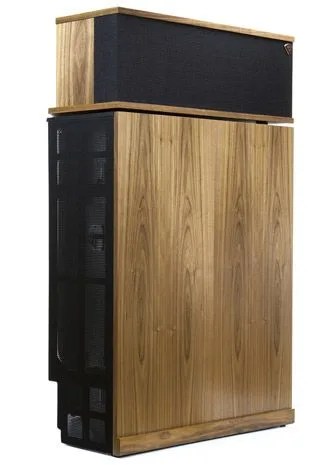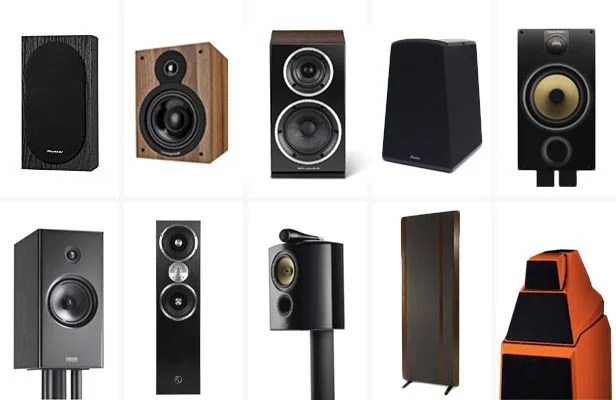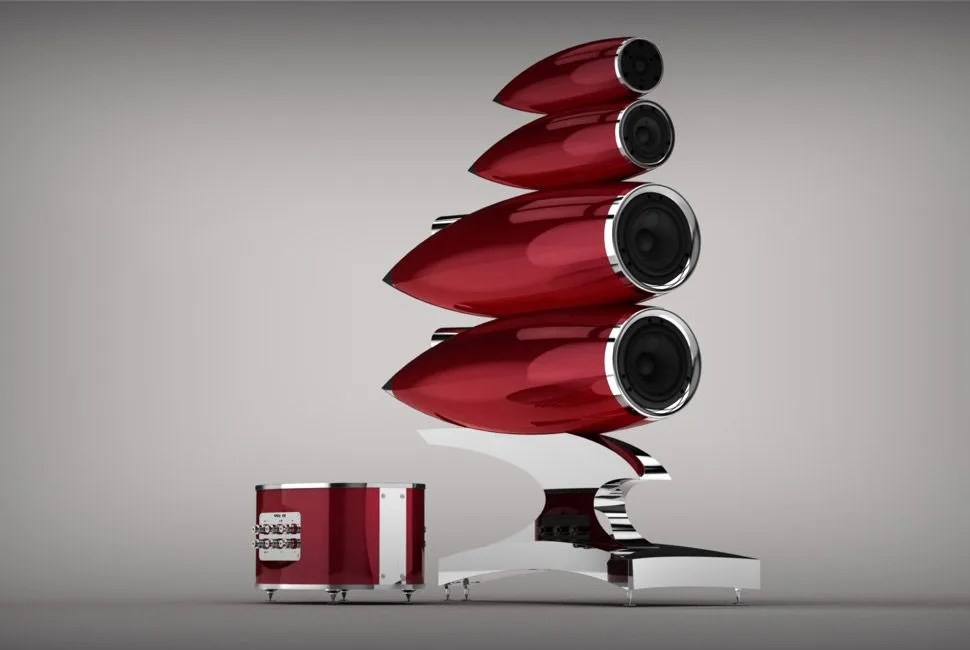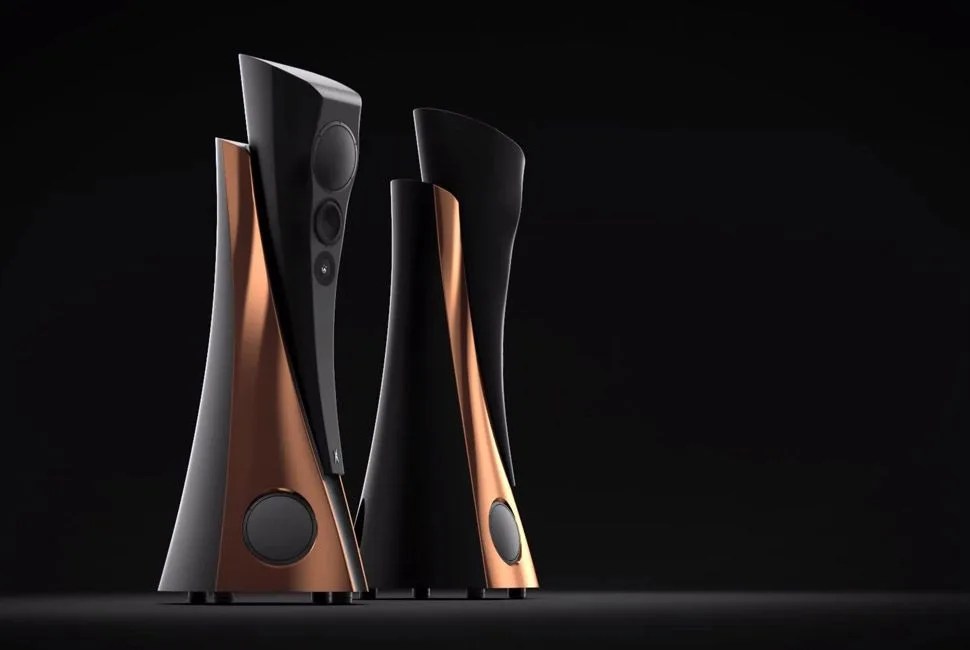What you think you know about speakers is really just a stereotype. That image of the little black box floating in your mind is merely one of many bright ideas eggheads have devised for making air move in response to an electrical charge. Technically, there are over 10 different categories of driver designs floating around in the world, each distinguished by their own set of advantages and drawbacks.
We’re not smart enough to understand them all. And some — yeah, we’re looking at you, Plasma Arc — don’t exactly seem like they’ll be eligible for Amazon Prime anytime soon. At any rate, we’ve done our best to boil the major highlights in the loudspeaker world down into one digestible guide.
So read on and scrawl what you need on your wrist before wandering into the hi-fi shop. We’re confident you’ll play the role of the informed buyer like the natural you are. And who knows, maybe you’ll even be inspired to start studying on your own.
Horn Loudspeakers

The oldest form of loudspeaker design dates back to the 17th century with the advent of the megaphone. How horns manage to amplify sounds without any additional power is a miracle of basic physics.
The fact is, most drivers of sound do a poor job of converting the mechanical energy in the surrounding air into acoustical energy. Attaching a horn to the front of a sound-driving element, however, drastically improves this so-called coupling efficiency, by allowing the source sound to better engage all of the air present inside the slowly widening area of “the throat.”
Powered horn loudspeakers leverage this effect much in the same way, to squeeze impressive sonic results from very low levels of amplification. This makes them often an intriguing option for pairing with acoustically superior but comparably underpowered tube-based amp systems. Unfortunately, horn loudspeakers must be very large in order to provide adequate levels of bass response, making many designs highly impractical for anyone who can’t afford a private Walmart to put them in.
Classic Example: Klipschorn Floorstanding Speaker | Oswalds Mill Audio Imperia
The Dynamic Driver

The dynamic driver is by far the most popular design found in the world of audio today. In fact, it’s what most of us imagine when we think of a speaker. Their basic design consists of a suspended lightweight cone attached to an electromagnet (usually a coil of copper wire), which itself is placed permanently in front of another magnet. When an amplifier applies electricity to the coil, it creates a magnetic field that grows and contracts in relation to the frequency of the audio signal. These directional changes in the field cause the coil to alternate between being attracted and repelled by the permanent magnet behind it. The resulting pull-and-push forces make the coil vibrate, which are in turn amplified by the connected cone to create sound.
The popularity of this type of driver stems from several notable advantages, including its relatively simple and rugged construction. It’s also highly sensitive, handles power in stride and is quite capable of outputting a wide dynamic range. The heavy nature of its components, however, does make the dynamic driver somewhat slower in responding to changes in audio frequency compared to other alternatives. Other acoustic downsides stem from the enclosure it’s mounted in.
Crossing Over
Crossovers, in an audio context, are a set of filters that split an incoming audio signal into two or three bands of frequency (think high, mid and low) so that different types of drivers — such as tweeters, woofers and subwoofers — can each handle the respective section of the audio spectrum they are optimized for reproducing. So-called active crossovers differ from passive crossovers by splitting an audio signal before it is amplified.
Most dynamic speaker drivers are built into airtight boxes to stop the emanating sound waves they invariably generate from distorting the output of the main cone. Ironically, trapping these undesirable sound waves creates a catch-22 known as resonance. Thicker walls, unique shaping and internal bracing can all help reduce the distorting effects of cabinet vibration. But too much rigidity can also cause these sound waves to simply reflect back — recreating the very problem cabinets are intended to prevent. Plenty of innovative solutions have been designed to minimize these influences, but none are perfect.
That’s not to say all that sonic influences created from a speaker’s cabinet are unquestionably bad. On the contrary, many listeners feel some level of “boxiness” provides a richness to music that’s missing in other speaker designs.
Classic Example: B&W 800 Series Diamond | B&W 801 Matrix Series 2 loudspeaker
Speaker Peacockin’
Avant-Garde and Iconic Loudspeaker Designs from the Past & Present
11 photos
Magnetostatic & Planar-Magnetic Loudspeakers

Part of the confusion around this speaker type (among other leaps of intellect) revolves around naming conventions. So-called planar-magnetic speakers are variations on the magnetostatic drive concept. To make things worse, Yamaha also promoted the term “Orthodynamic” in the headphone world as a way to brand their planar-magnetic headphone technology.
A magnetostatic driver ditches the copper voice coil and cone used in its dynamic counterpart in favor of metal strips bonded directly to a membrane. Magnetic strips are then placed behind this membrane to create a static magnetic field. As audio frequency currents are run through the conducting metal strips in the membrane, the forces of attraction and repulsion between the metallic bands and the permanent magnets cause the entire membrane to move, creating sound.
The physics behind this method mean that magnetostatic loudspeakers and related variations are quite big and thin compared to traditional dynamically driven options. This awkward form factor presents an obstacle for many looking for an audio setup that blends nicely with the rest of their home. They also require amplifiers capable of matching their low-impedance demands.
Those who can accommodate their design are rewarded, however, with incredibly accurate sound that’s free of the resonance issues that color the output of traditional loudspeakers. Because of this, most speakers of this type on the market today offer hi-fi performance at costs that are significantly lower than their comparable dynamically driven counterparts.
Classic Examples: Magnepan 1.6/QR
10 Hi-Fi Speakers for Every Budget

Pioneer SP-BS22-LR: $129
Cambridge Audio SX-50: $249+
Wharfedale Diamond 122: $299
GoldenEar Aon 3: $500/ea
B&W 685 S2: $800
Zu Audio Omen Def Mk. 11 $3,600
B&W Diamond 805 Diamond: $5,000
Magnepan 20.7: $13,850
Wilson Audio Specialties Alexia: $47,500
Electrostatic Loudspeakers

Like magnetostatics, electrostatic loudspeakers are large and flat in design, but operate according to different principles — relying on high-voltage electric fields over magnetic fields to generate sound.
A thin plastic membrane, usually made from polyester film, is coated with a conductor to form a diaphragm in this case. This diaphragm is then sandwiched equidistantly between two conductive grids, often made of perforated metal sheets framed with wire. Still with us? Well, here’s where things get a bit more dense.
Sound is created from this setup by sending electricity to the central membrane while an identical audio signal is sent to both conductive grids in anti-phase (roughly meaning positive on one side and negative on the other), creating a uniform electrostatic field. This field puts a “push-pull” force on the diaphragm and in turn the moves air on either side.
This design has the distinct advantage of reducing sonic distortion by an order of magnitude compared to basic dynamic cone drivers. Because they’re so light, they also exhibit exceptional frequency response. However, the restricted movement of the membrane limits the amount of air volume that can be pushed, a shortcoming that manifests in the form of poor bass reproduction. Playing close consideration to where electrostatic loudspeakers are placed in a room is also critical, since the physics of sound reflection has a major impact on their sound quality.
Classic Examples: Martin Logan CLXM | Quad “ESL-57”











